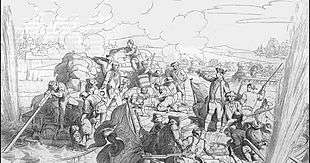Venetian bombardments of the Beylik of Tunis (1784–1788)
| Bombardments of Tunis' Bay (1784-1788) | |||||
|---|---|---|---|---|---|
 Angelo Emo bombards the city of Sfax, from a drawing of Giuseppe Gatteri | |||||
| |||||
| Belligerents | |||||
|
| Beylik of Tunis | ||||
| Commanders and leaders | |||||
|
| Hammuda ibn Ali | ||||
| Strength | |||||
|
various sailing ships, 2 bomb vessels, up to 9 bomb raft |
Coastal defences and naval batteries, several pirate' ships | ||||
The bombardments of the Beylik of Tunis (June 1784 – 1788) were a series of Venetian naval bombardments of the capital and various cities of the Beylik of Tunis in order to force Bey Hammuda ibn Ali to stop supporting the pirates that harassed the trade routes of the Most Serene Republic of Venice. The campaign lasted four years, during which the Venetian fleet at the orders of Angelo Emo greatly increased in both number and power.
The Bombardments
1784: the first raid against Sousse
On 21 June 1784, the Capitano Straordinario delle Navi (admiral) of Venice, Angelo Emo, went out the port of Malamocco. He commanded a squadron composed by two ships of the line, the 70-gun Forza under rear-admiral Giovanni Moro, his second-in-command, and the 66-gun Fama, his own flagship, the 38-gun frigate Palma, two bomb vessels (the Polonia and the Distruzione), one 22-gun xebec and one 12-gun galiot.
Slowed down by bad weather conditions, the squadron, after a brief stop at the Bocche di Cattaro to embark a company of marines and 60 sailors, arrived at Corfù only in July.
At the time, in Dalmatia the Black Death was ravaging the city of Spalato, and all the ports and cities of this province were under quarantine. Given that men from Kotor could be infected, Emo could not drop anchor in that harbour until 7 August. The Venetians started to do shooting practices with the heavy mortars of the bomb vessels (two 340-pounders and two 135-pounders), that evidenced some issues to their beds. Here in Corfù the squadron was joined by the 56-gun heavy frigate Concordia and another 22-gun xebec.
On 18 August, Emo was in sight of Sicily. On 26 August, he passed the island of Malta; and on 30 August, he arrived in the bay of Tunis. Here the squadron was targeted by the terrible weather, unable to move for three days. On 3 September, the Venetian ships – while sailing to get closer to the city – found a Neapolitan tartana (a type of small merchant ship) that had been captured by the Barbary pirates shortly after and re-captured it.